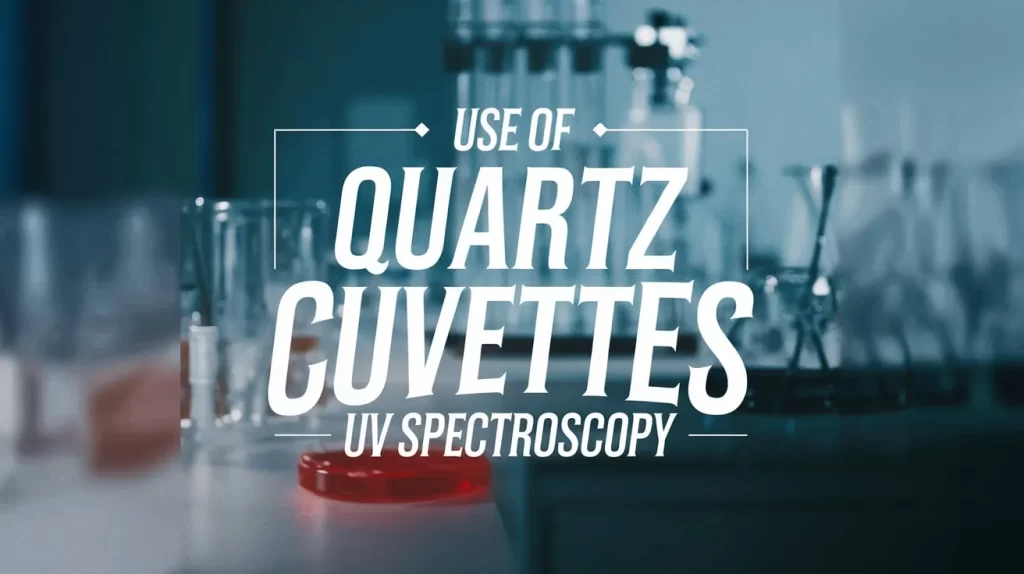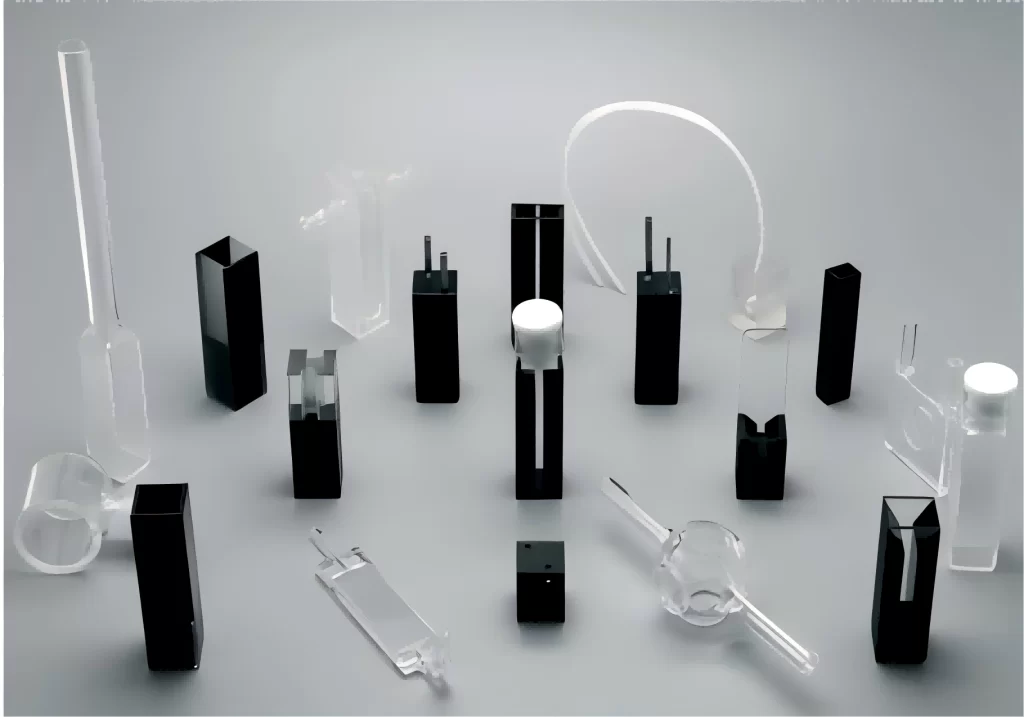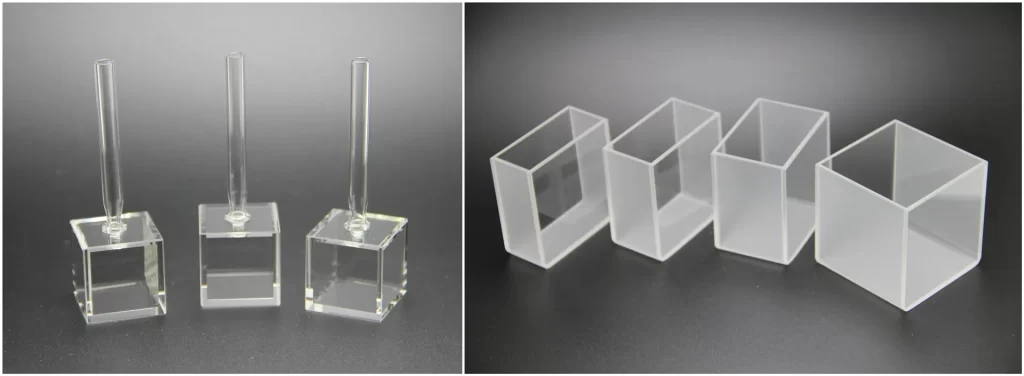Why Quartz Cuvettes Are Used In UV Spectroscopy?
Learn why quartz cuvettes are essential for accurate UV-vis spectroscopy results below 340nm. Discover how their excellent transmission and reuse potential provides precise measurements and consistency across tests.
Why Use Quartz Cuvettes for UV Spectroscopy Experiments and Research?
Have you ever wondered why scientists use those little glass tubes called cuvettes when doing spectroscopy experiments? I used to think they all looked the same, but it turns out there’s a really good reason for picking the material carefully, especially when working with UV light.
In my research, I learned that quartz cuvettes are super important for getting accurate results in UV spectroscopy below 340 nm. It comes down to the fact that quartz transmits UV light much better than other materials like plastic or regular glass.
Those tend to absorb UV rays which interfere with the measurements. But quartz has awesome transmission from 190 nm to 2500 nm, so it doesn’t get in the way at all.
What is a Cuvette?
A cuvette is a small container used to hold liquid samples for analysis in spectroscopy experiments. Cuvettes allow you to use light waves to measure the sample inside without interference from the cuvette material itself. They are made to be transparent for the wavelengths used.
Cuvettes have precise dimensions, especially thickness, and optical properties to work for absorption studies on solutions. They are commonly rectangular with straight sides and square cross-sections to prevent issues with refraction. The most often used cuvettes are made of plastic, glass, or fused quartz.
Parts of a Cuvette
Cuvettes have a few key components:
- They are sealed at one end and open at the top to insert the sample.
- Two clear opposite sides allow the spectrophotometer light to pass through linearly.
- Some have two additional perpendicular sides polished for fluorescence measurements.
- They may have caps to contain hazardous samples or prevent evaporation.
Using a Cuvette
Using a cuvette properly is important for accurate results:
- Carefully fill with your liquid sample, avoid overfilling past 80% full.
- Wipe all outer surfaces clean before use to remove fingerprints or dust.
- Insert vertically and consistently into the spectrophotometer holder.
- Take care with solvents and temperatures to avoid damaging the cuvette.
- Rinse thoroughly between samples, especially with different solvents.
- Handle gently by the frosted sides to prevent scratches on clear windows.
Types of Cuvette Materials
There are several common materials used to make cuvettes, each with its own advantages and best uses. Selecting the right material is crucial for getting accurate results in your spectroscopy experiments. Let’s go over the key options:
Plastic Cuvettes
Plastic cuvettes like PMMA or PS have a usable wavelength range of 380-780nm, covering visible light only. They are cheap and disposable, avoiding contamination from reuse. However, plastic absorbs UV light, so it is not suitable for UV spectroscopy.
Glass Cuvettes
Optical glass cuvettes have a transmission range of 340-2500 nm. They work well for visible light and some near-infrared applications, but absorb strongly in the UV range. Glass cuvettes are more durable and reusable.
Quartz Cuvettes
Fused quartz is exceptionally transparent from 190-2500 nm. With excellent UV transmission, a quartz cuvette is ideal for UV-vis-NIR spectroscopy. Quartz also withstands higher temperatures and is chemically inert. This makes quartz the most durable cuvette option. However, it is also the most expensive material.
Infrared Quartz Cuvettes
IR quartz expands the transmission range to 220-3500 nm. This covers near, mid and far infrared regions in addition to UV-vis. IR quartz resists chemical attacks for reliable measurements.
Sapphire Cuvettes
Sapphire is the hardest and most scratch-resistant material for cuvettes. It has extremely broad transmission from 250-5000 nm, covering UV, visible, and mid-infrared. Sapphire withstands the most extreme sample conditions. But it is also the costliest cuvette option.
Compared with plastic cuvettes are cheap for visible light use, quartz and sapphire provide the best transmission and durability for demanding UV and IR spectroscopy applications.
Glass cuvettes offer a compromise, transmitting UV better than plastic while costing less than quartz.

Why Use Quartz Cuvette for UV Spectroscopy?
Quartz is the ideal cuvette material for accurate UV spectroscopy results below 340nm. Its excellent UV transmission, chemical resistance, thermal stability and reuse potential provide major advantages over glass and plastic options that absorb UV light and interfere with measurements.
While more expensive initially, quartz cuvettes greatly benefit UV experiments through reusable design, scratch resistance, and flexibility.
Quartz Transmits UV Light
Quartz cuvette remains transparent down to 190 nm, while glass and plastic absorb UV rays, interfering with results. This makes quartz cuvette crucial for accurate UV-VIS measurements below 340 nm.
High Accuracy and Reproducibility
With low background absorbance, the excellent transmission of quartz cuvette gives precise sample readings. The durable quartz material also yields very consistent results over repeated tests.
Withstands Solvents and Heat
Quartz cuvette is chemically inert, resisting degradation from most common solvents. This allows repeat testing of samples without any effect on the cuvette material. Quartz cuvette also has high thermal stability across a wide temperature range, providing reliable results.
Reusable and Scratch Resistant
Compared with disposable cuvettes, quartz cuvettes can be carefully cleaned and reused many times. The hard quartz material is very resistant to scratching during routine handling and cleaning. Scratches can cause errors in measurements.
Flexible Applications
Quartz cuvette is available in many different configurations to suit varying applications. For fluorescence quartz cuvettes, can have all 4 sides polished. Flow cells may need just 2 transparent sides for the light path.
Worth the Investment
Although quartz glass cuvette does cost more, the reuse provided helps offset the initial price. And for critical UV applications, where others simply won’t work, quartz cuvette is worth the extra investment. It prevents wasted tests and lost data from improper cuvette materials.
The unique advantages of quartz make it the top choice for reliable and accurate UV spectroscopy.
Factors in Cuvette Selection
When we talk about factors in cuvette selection there are several key factors to consider when selecting the right cuvette for your spectroscopy application. The cuvette material, dimensions, volume, and special features should all be matched to the specific sample properties, testing methods, and instrument requirements.
Intended Use and Wavelength
The cuvette material must be transparent to the wavelengths used. Plastic and glass work for visible range only. Quartz is required for UV spectrum experiments. Consider the light source in your spectrometer cuvettes when choosing materials.
Sample and Solvent Properties
Use quartz cuvettes if your samples contain organic solvents. Glass and plastic can degrade with solvent exposure while quartz is inert. For aqueous solutions, any material may suffice.
Cuvette Volume and Dimensions
Base the size on your sample quantity. 10mm path length cuvette is most common but lengths range from 1-100 mm. Cross-sections also vary. Ensure the cuvette fits your instrument.
Sensitivity Requirements
Short path cuvettes suit concentrated samples that overload standard length. Long-path cuvettes help measure dilute solutions without enough absorbance. Adjust path length to optimize the signal.
Reusability Preferences
Disposable plastic cuvettes avoid contamination between tests. But reusable quartz/glass can be cleaned for many uses. Balance contamination risks versus reuse savings.
Special Applications
The fluorescence cuvette needs 4 polished sides for signal collection. Flow cells require 2 transparent path sides. Macro cuvettes enable easy heating and mixing.
Budget Limitations
Plastic cuvettes are the cheapest while quartz costs the most. Glass is a compromise on price. Prioritize key material and feature needs versus cost savings.
You may match the cuvette specifications to your particular spectroscopy application needs. This ensures accurate results by optimizing the sample properties, testing methods, and instrument criteria.

Proper Cuvette Handling
Proper cuvette handling is crucial because they are easy to contaminate, and it can lead to measurement errors. Here are some simple tips on how to do everything correctly:
- Do not let your fingerprints and water droplets on the transparent optical surfaces. They can scatter the light path and change your results. To avoid it, clench the outer surfaces with a soft, lint-free, nonabrasive cloth. If some dirt is left, a wash is a mixture of a mild detergent or solvent.
- Always insert the cuvette into the spectrophotometer holder vertically and in the same orientation. If you rotate it, the optical path length will change. From time to time measure materials from one cuvette and from time to time another – this will save your results in an ideal state
- Never touch the transparent optical windows of the cuvette. Always take it by frosted or opaque sides or edges. It is done to prevent scratching, and do not let the scratches scatter the light.
- Do not strike the cuvette with any object because it can chip or even crack. In addition, try not to drop it.
- Always put a cap on the cuvette when it is not in use. It prevents the sample from evaporating and keeps the inner environment sterile.
Conclusion
To sum up, quartz cuvettes are the only choice for UV spectroscopy providing accuracy and reliability due to their uses below 340 nm. The excellent UV transmission, durability, and conveyor application ensure precise and uniform measurement over multiple experiments. Even though more expensive initially, the examined element pays for itself through effectiveness and long-term usability.
An adequately maintained quartz cuvette will be viable over the course of an unknown number of experiments due to the referenced properties. As such, the need to ensure that the item selected for each specific investigation resembles consideration of its properties allows for superior accuracy.
Overall, with the appropriate quartz cuvette selections, Uv spectroscopy experiments will greatly benefit from precision, accuracy, and the ability to be repeated.


hello